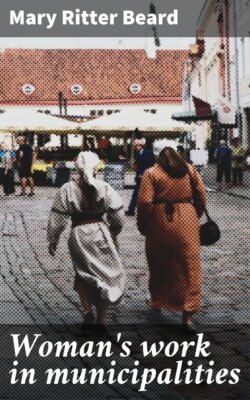Читать книгу Woman's work in municipalities - Mary Ritter Beard - Страница 17
District Nursing
ОглавлениеCare of the sick in hospitals, as everyone knows, depends almost as much upon efficient nursing as upon the skill of the physician—in many cases, far more. Of the labors of nurses for humanity, it is not necessary to speak here. But in our present public health campaign, a new type of nurse has appeared, “the visiting nurse,” who watches homes to guard against disease as well as to cure, and she is now regarded by competent observers as the strategic point in the battle for improved health in our cities and towns.
Ysabella Waters in her examination into the system of visiting nursing in the United States shows that in 1913 “50 health departments employed 867 visiting nurses, including 345 school nurses, 350 tuberculosis nurses, 107 infant hygiene nurses and 65 employed in other fields of sanitary work. At the same time 64 departments of education reported the employment of 200 visiting nurses in their work and Miss Waters obtained records of 2,367 nurses taking part in public health work under other auspices, most of them being engaged in the campaign against tuberculosis.”
An excellent system of district nursing is that developed by Miss Lillian Wald from her Nurses Settlement in New York City, and, according to Professor Winslow, it was due to her far-sightedness and organizing ability that the application of the educational force of district nursing was made to the problem of tuberculosis. Miss Wald’s belief that the hospitals can never cope with disease and that home treatment is better and more practicable is borne out by the figures given for the total number of patients treated last year by the district nurses which indicates that the number visited and cared for was larger than the number treated by three large city hospitals in the same space of time. Ten per cent. is the proportion usually cited as the ratio of the sick taken to hospitals. Miss Wald contends that the treatment of patients in their homes, especially where children are concerned, is preferable to hospital care in most cases, and can be carried on in a way that compares favorably with the treatment accorded in hospitals and by the private nurse in the homes of the well-to-do.
Miss Wald began her work for public nursing twenty-four years ago and has steadily pushed its importance into public recognition and changed the official attitude, as well as the attitude of doctors and laymen, from that of indifference or contempt to that of sympathy and understanding and public support.
In other cities, the idea has been taken up and developed in many ways. The Visiting Nurses’ Society of Philadelphia wants to increase its force to enter industrial nursing and here as elsewhere in the various aspects of nursing, the demand for training far exceeds the equipment. Here, too, just as the hospital nurse soon sees the necessity of economic backgrounds for cure and prevention of disease, so the industrial nurse is seeing and writing on the causes and prevention of ills among working men and women. They are greatly aided in this study by that splendid contribution by Miss Goldmark on “Fatigue and Efficiency.”
Los Angeles was the first city to municipalize the district nurse, and this bold step was taken at the instigation of Mrs. Maude Foster Weston and the College Settlement workers who furnished statistics and reports, which they themselves had gleaned from their own observations with private district nursing, to prove that such a step was municipally advantageous. The first school nurse was also secured in that city through the efforts of the same women. In 1909 a practical demonstration was given of the value of the district nurse in daily coöperation with the city physician in controlling an epidemic of measles.
Mrs. Weston thus explains the woman’s point of view about this work: “Someone has said that infant mortality is the most sensitive index we possess of social welfare. It may be that in our fair climate we need never reach the appalling records of our eastern cities, but we who know the true state of things in Los Angeles believe that if there is not more care of our newly-born, that, while the death list may not compare with the East, we shall produce a sickly, ailing set of children who will be unable, at maturity, to cope with disease. We are accused of standing for a sort of social service which has to do with the effects only and not with the causes which create them. … We approach however our problems in a modern and scientific manner and we always seek for causes.”
The Women’s Municipal League of Boston has made a thorough study of public nursing and has adopted a scheme whereby the nurse and houseworker are combined. This system is called Household Nursing and its aim is to be self-supporting. The nurses are called “attendants” and the problem of their training has had to be worked out by patient experimentation.
Significant of the times, too, is the awakening of the women of the negro race as well as of the white. The negro woman is especially adapted through her past experiences for the profession of nursing and now, with the addition of scientific training, a means of skilled employment, coupled with an opportunity to render public service, in addition to her age-long domestic service, is open to her.
Women are developing largely for themselves the whole science of training for public nursing. The National Organization for Public Health Nursing has a broad social point of view, realizing that upon the district nurse rests the responsibility of applying in a very practical way among the people the results of scientific thought and research.
